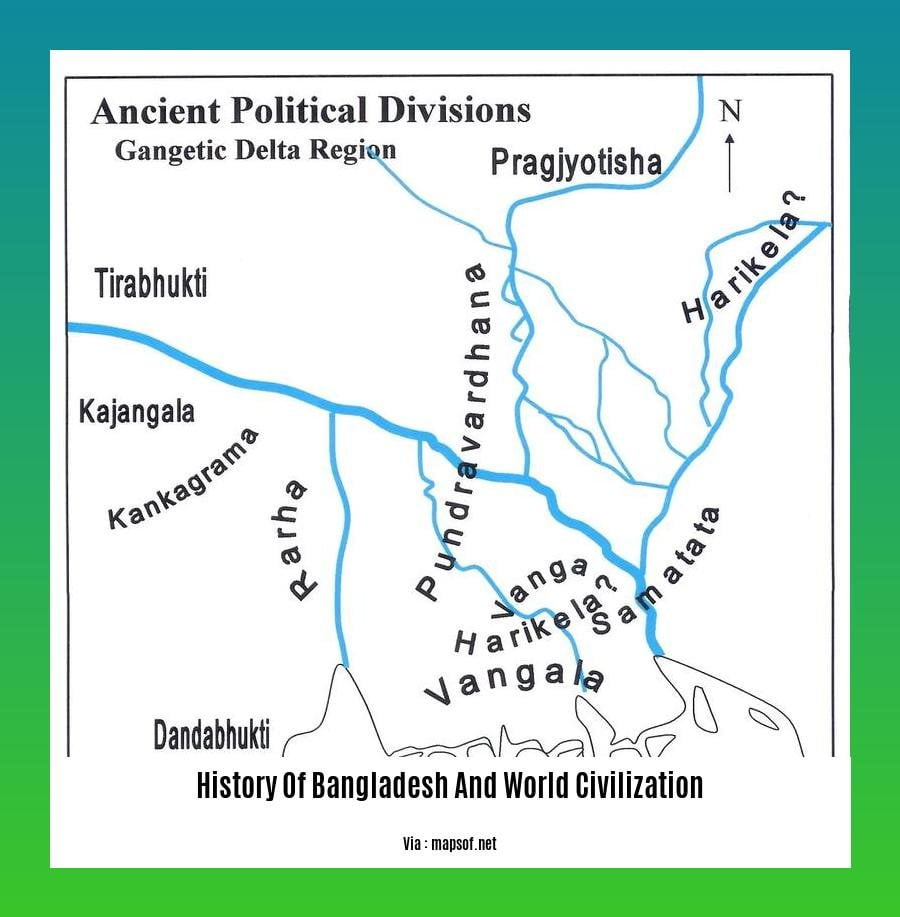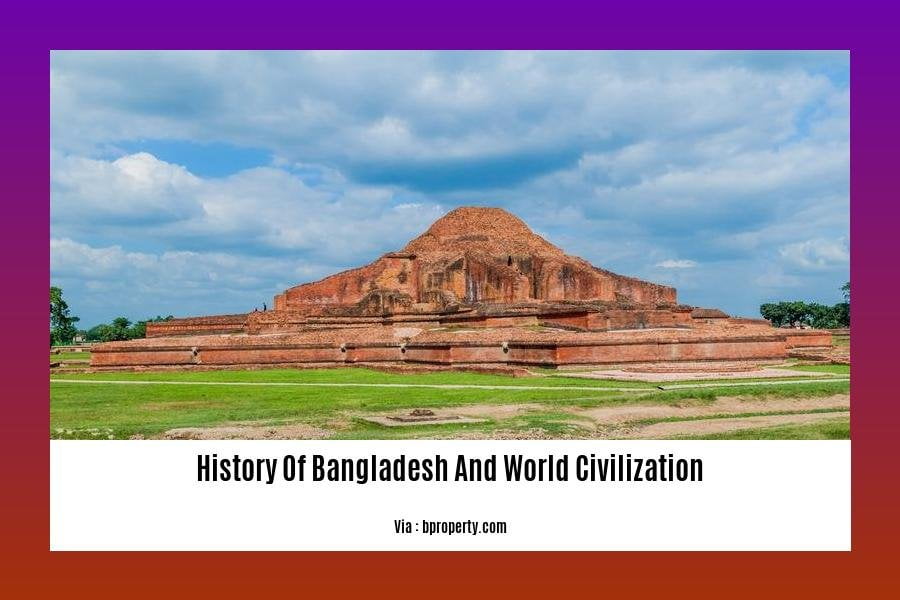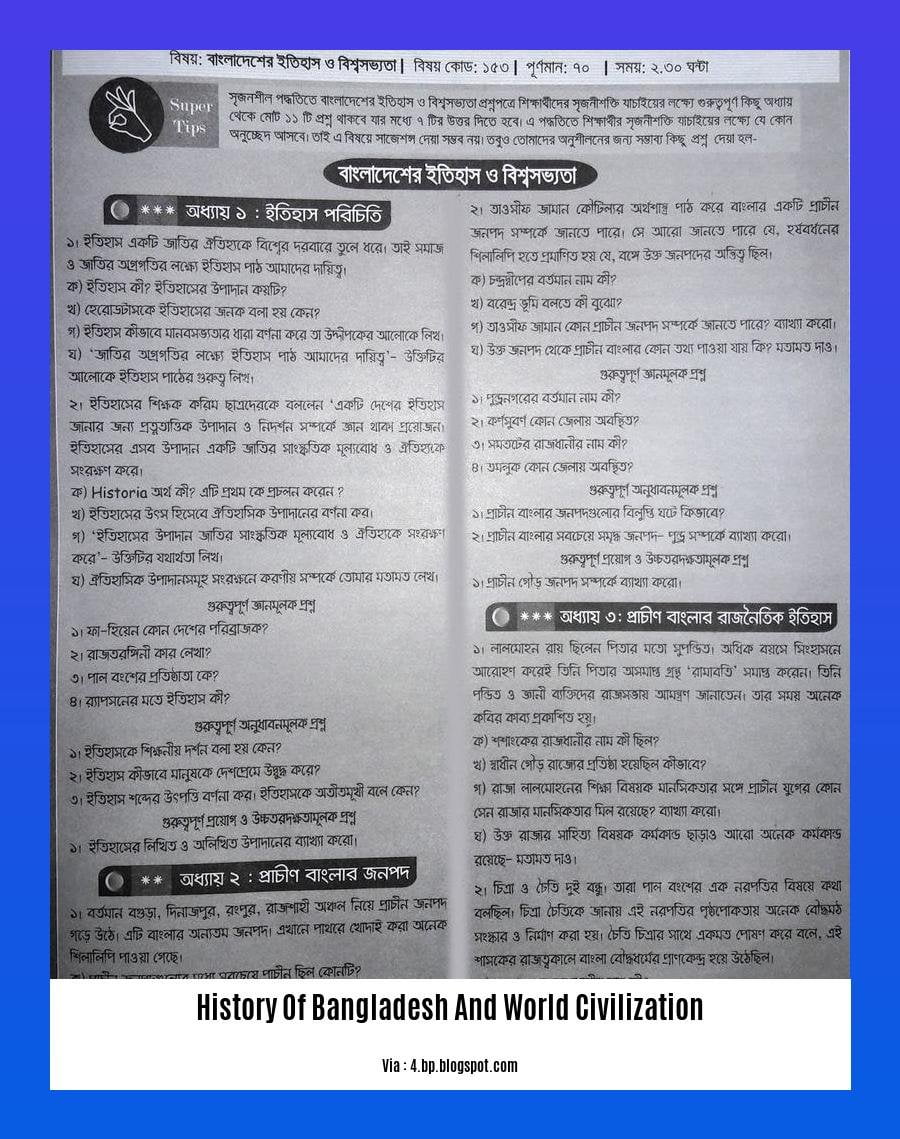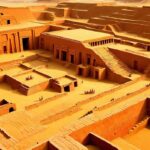In a world where civilizations have intertwined to create a rich tapestry of human history, Bangladesh stands as a treasure trove of cultural heritage that has profoundly influenced the course of global developments. This article, titled [Exploring the Interwoven History of Bangladesh and World Civilization], delves into the captivating narrative of how this vibrant land has been an integral part of global connectivity, shaping and being shaped by the forces that have driven humanity’s progress.
Key Takeaways:
- Bangladesh’s intricate history is closely interwoven with that of India, Pakistan, and other nations of South Asia.
- Bangladesh has a rich cultural legacy that includes several Hindu and Buddhist kingdoms and empires dating back to the Chalcolithic era.
History of Bangladesh and World Civilization

The Historic Tapestry of Bangladesh: A Global Narrative
Bangladesh, a land of vibrant history and rich cultural heritage, has long been intertwined with the broader tapestry of world civilization. This captivating story unfolds through various civilizations, empires, and cultural exchange, leaving an indelible mark on global history.
Ancient Heritage, Profound Roots
Bangladesh’s ancient legacy stretches back to the Chalcolithic period, where Hindu and Buddhist kingdoms flourished. These early civilizations laid the foundation for cultural traditions, contributing to the region’s diverse religious heritage.
Bengali Warriors and Sultans: A Legacy of Resilience
The medieval era witnessed the rise of powerful Bengali warriors and the establishment of sultanates. These rulers, with their military prowess and administrative skills, crafted a distinct chapter in Bangladesh’s history, leaving behind impressive architectural marvels like mosques and forts.
Mughal Splendor and Cultural Fusion
In the 16th century, the Mughal Empire extended its influence over Bangladesh. This period marked a fusion of Islamic and Bengali cultures, leading to advancements in art, architecture, literature, and music. The Mughal era left a profound impact on Bangladesh’s cultural identity.
British Colonialism: A Transformative Experience
The arrival of the British in the 18th century brought about a transformative period in Bangladesh’s history. The introduction of Western ideas and technologies sparked social and economic changes, while the Bengali Renaissance emerged as a cultural and intellectual movement.
Language, Identity, and the Birth of Bangladesh
The struggle for linguistic and cultural rights gained momentum in the 20th century, culminating in the birth of Bangladesh as an independent nation in 1971. This chapter in Bangladesh’s history showcased the resilience and determination of its people, reinforcing their cultural and historical connection to the world.
Global Connections: A Shared Heritage
Bangladesh’s story is intrinsically linked to the histories of India, Pakistan, and other South Asian countries. These shared experiences bind the region together, creating a tapestry of intertwined cultural traditions and historical events.
Bangladesh Today: A Cultural Melting Pot
Modern Bangladesh is a vibrant fusion of ancient traditions and contemporary influences. The country’s cultural heritage, rooted in its rich history, continues to shape its art, literature, music, and cuisine. Bangladesh stands as a testament to the enduring power of history, where the past and present converge to create a unique and captivating cultural landscape.
Discover the captivating historical narrative of Andul Rajbari by delving into its rich past and cultural significance. history of andul rajbari
Unravel the mysteries of Bohol’s intriguing history, from its ancient origins to its vibrant present. Immerse yourself in the island’s captivating tales and legends. history of bohol
The Maritime History of Bangladesh and Its Impact on Trade and Cultural Exchange
Bangladesh: A Crossroads of Maritime Trade
Bangladesh, a nation nestled in the heart of the Bay of Bengal, boasts a rich maritime history that has shaped its cultural tapestry and fueled its economic growth. Its extensive network of rivers and strategic location have transformed it into a vibrant hub of trade and cultural exchange throughout the centuries.
The Rise of Chittagong: A Gateway to the East
Chittagong, Bangladesh’s principal seaport, has long served as a gateway for maritime trade, connecting the country to the bustling markets of the Indian Ocean and beyond. This strategic location allowed Bangladesh to flourish as a center of commerce, facilitating the exchange of goods, ideas, and cultures between East and West.
The Sundarbans: A Natural Wonder and Trade Route
The Sundarbans, the world’s largest mangrove forest, played a crucial role in Bangladesh’s maritime history. This vast ecosystem provided a safe haven for ships seeking shelter from storms and served as a vital trade route, connecting the country to Southeast Asia and China. The Sundarbans’ unique biodiversity also contributed to the region’s economic prosperity, with fishing and forestry becoming key industries.
Cultural Exchange: A Tapestry of Influences
Bangladesh’s maritime history has left an indelible mark on its cultural fabric. The country’s cuisine, art, and music reflect the diverse influences of traders, sailors, and travelers who visited its shores. From the aromatic spices of the Middle East to the vibrant textiles of Southeast Asia, Bangladesh’s cultural heritage is a testament to its rich maritime past.
The Future of Bangladesh’s Maritime Industry
Today, Bangladesh’s maritime sector continues to play a vital role in its economy. The government is investing heavily in port infrastructure and developing new trade routes to boost exports and attract foreign investment. With its strategic location and skilled workforce, Bangladesh is poised to become a major player in the global maritime industry.
Key Takeaways:
- Bangladesh’s extensive network of rivers and strategic location have made it a hub of trade and cultural exchange throughout history.
- Chittagong Port has served as a gateway for maritime trade, connecting Bangladesh to markets in the Indian Ocean and beyond.
- The Sundarbans mangrove forest provided shelter for ships and facilitated trade with Southeast Asia and China.
- Bangladesh’s maritime history has influenced its cuisine, art, and music, creating a rich cultural tapestry.
- The government is investing in port infrastructure and developing new trade routes to boost the country’s maritime industry.
References:
- The Maritime History of Bengal
- The Future of Mariculture Development in Bangladesh within the Framework of the “Blue Economy” Concept
The role of Bangladesh in the European colonial era

In the tapestry of world history, the European colonial era stands as a period of profound transformation, leaving lasting imprints on nations and cultures across the globe. Bangladesh, nestled in the heart of South Asia, was no exception to this transformative era. Under British rule from the 18th to mid-20th century, Bangladesh witnessed significant changes that shaped its socio-political landscape, economy, and cultural identity.
The Bengal Presidency:
When the British East India Company set foot on the Indian subcontinent in the 17th century, it found a prosperous and culturally rich region. Bengal, a province that encompassed present-day Bangladesh, was at the heart of this vibrant tapestry. The company’s presence in Bengal grew steadily, and by the mid-18th century, it had established itself as the dominant power in the region.
Economic Transformation:
British rule brought about significant economic changes in Bengal. The introduction of a cash crop economy, with a focus on jute and indigo, led to the restructuring of agricultural practices and land ownership patterns. This shift had a profound impact on the lives of Bengali peasants and farmers, who were often forced into debt and exploitation.
Administrative Restructuring:
The British reorganized the administrative structure of Bengal, dividing it into districts and subdivisions. This restructuring aimed to streamline governance and increase the efficiency of tax collection, but it also resulted in a loss of local autonomy and a weakening of traditional power structures.
The Bengal Renaissance:
Amidst the challenges of colonial rule, a cultural and intellectual awakening took place in Bengal known as the Bengal Renaissance. This movement sought to revive Bengali language, literature, and culture and promote social and political reforms. Figures like Raja Ram Mohan Roy and Ishwar Chandra Vidyasagar emerged as leaders of this movement, advocating for education, women’s rights, and the abolition of harmful practices like sati.
Partition and Independence:
The partition of Bengal in 1905, which divided the province along religious lines, sparked widespread protests and unrest. This event became a catalyst for the Indian independence movement, and Bengal played a pivotal role in the struggle for freedom from British rule. In 1947, Bengal was divided once again, with the eastern part becoming East Bengal, which later became part of Pakistan. In 1971, East Bengal gained independence and emerged as the nation of Bangladesh.
Key Takeaways:
- British rule in Bengal brought about economic, administrative, and cultural changes.
- The introduction of a cash crop economy led to shifts in agricultural practices and land ownership.
- The Bengal Renaissance emerged as a cultural and intellectual movement promoting social and political reforms.
- The partition of Bengal in 1905 fueled the Indian independence movement.
- Bangladesh gained independence in 1971 after a bloody liberation war.
Citations:
– Bangladesh
– History of Bangladesh
The Legacy of Bangladesh in the Modern World
Bangladesh’s rich history and vibrant culture have left an indelible mark on the modern world, contributing in various ways to global development. Let’s explore how this South Asian nation has shaped our contemporary world.
1. Cultural Diversity and Harmony:
Bangladesh is a melting pot of various ethnicities, religions, and languages, showcasing a remarkable unity in diversity. This cultural tapestry has fostered tolerance, understanding, and peaceful coexistence among different communities, serving as a model for harmonious societies worldwide.
2. Language and Literature:
The Bengali language, spoken by over 200 million people worldwide, is a significant literary force. Renowned for its rich vocabulary and expressive power, Bengali literature has produced literary giants like Rabindranath Tagore, whose works have been translated into over 100 languages.
3. Art and Architecture:
Bangladesh’s artistic heritage is expressed in its diverse art forms, including intricate handicrafts, vibrant paintings, and mesmerizing music. The country’s architectural wonders, like the majestic Lalbagh Fort and the Sixty Dome Mosque, showcase a fusion of Islamic, Hindu, and European influences, leaving a lasting impact on global architectural styles.
4. Women Empowerment:
Bangladesh has made significant strides in women’s rights and empowerment. Grameen Bank, a microfinance institution founded by Muhammad Yunus, has revolutionized financial inclusion for women, providing them with access to credit and empowering them to become entrepreneurs. This model has inspired similar initiatives worldwide.
5. Climate Change Mitigation:
Recognizing the urgency of climate change, Bangladesh has emerged as a global leader in climate change adaptation and mitigation strategies. The country’s efforts to combat climate change, including the promotion of renewable energy, afforestation, and sustainable agriculture, have earned international recognition and emulation.
Key Takeaways:
– Bangladesh’s cultural diversity and harmony serve as a model for peaceful coexistence.
– Bengali literature has a global impact, with renowned authors like Rabindranath Tagore.
– Bangladeshi art and architecture showcase a unique blend of cultural influences.
– Grameen Bank’s microfinance model has revolutionized women’s empowerment globally.
– Bangladesh leads in climate change adaptation, inspiring global efforts.
Sources:
– Bangladesh: A Cultural Tapestry
– Women’s Empowerment in Bangladesh
FAQ
Q1: How did Bangladesh’s history intertwine with that of the world?
A1: Bangladesh’s history is deeply interwoven with that of the world due to its strategic location and rich cultural heritage. The country served as a vital trading hub in the ancient world, connecting the Indian subcontinent with Southeast Asia and beyond. Additionally, Bangladesh’s cultural influences, such as its unique blend of Hindu, Buddhist, and Islamic traditions, have left a lasting impact on global art, architecture, and literature.
Q2: What are some of the key historical events that shaped Bangladesh’s development?
A2: Bangladesh’s history has been marked by several pivotal events that have shaped its development. These include the arrival of Islam in the 8th century, which transformed the region’s religious and cultural landscape. The Mughal Empire’s rule over Bangladesh from the 16th to the 18th centuries left a lasting legacy, including the construction of architectural wonders such as the Lalbagh Fort. The British colonization of Bengal, of which Bangladesh was a part, had a profound impact on the country’s economy, society, and politics. Finally, the Bangladesh Liberation War in 1971, which led to the country’s independence from Pakistan, was a defining moment in its history.
Q3: How has Bangladesh’s maritime history influenced its development?
A3: Bangladesh’s extensive network of rivers and its strategic location on the Bay of Bengal have played a crucial role in its development. The country’s maritime history dates back to ancient times, with Chittagong Port serving as a vital trading hub connecting the Indian subcontinent with Southeast Asia. This maritime trade led to cultural exchanges and the spread of ideas, technologies, and goods. In recent years, Bangladesh has focused on developing its mariculture industry, which holds great potential for economic growth and sustainability.
Q4: What are some of the challenges that Bangladesh has faced throughout its history?
A4: Bangladesh has faced several challenges throughout its history, including natural disasters such as cyclones and flooding, which have caused widespread devastation and loss of life. The country’s struggle for independence from Pakistan in 1971 was a challenging period marked by conflict and human suffering. Additionally, Bangladesh has grappled with issues of poverty, inequality, and political instability. Despite these challenges, the country has made significant progress in recent years, achieving economic growth and improving living standards. Bangladesh is also recognized for its resilience in the face of adversity.
Q5: What is the significance of Bangladesh’s history for understanding world civilization?
A5: Bangladesh’s history is significant for understanding world civilization due to its unique position as a crossroads of cultures and civilizations. The country’s rich cultural heritage, blending Hindu, Buddhist, and Islamic influences, has contributed to the development of a diverse and vibrant society. Bangladesh’s maritime history, with its extensive trading networks, facilitated cultural exchanges and the spread of ideas and technologies. The country’s struggle for independence and its subsequent development journey offer valuable lessons for other nations seeking to overcome challenges and achieve progress. Understanding Bangladesh’s history provides a lens through which to explore the interconnectedness of human civilizations and the impact of local events on global developments.
- SYBAU See You Baby Meaning: Gen Z Slang Evolves - July 1, 2025
- Unlock Your Inner Youth: Lifestyle Secrets for a Vibrant Life - July 1, 2025
- Decode SYBAU Meaning: Gen Z Slang Explained - July 1, 2025






